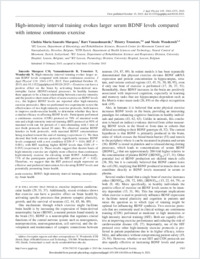High-intensity interval training evokes larger serum BDNF levels compared with intense continuous exercise.
- Saucedo Marquez CM KU Leuven, Department of Kinesiology and Rehabilitation Sciences, Research Center for Movement Control and Neuroplasticity, Heverlee, Belgium;
- Vanaudenaerde B KU Leuven, Pneumology Division, University Hospital, Leuven, Belgium.
- Troosters T KU Leuven, Department of Rehabilitation Sciences and Respiratory Division, University Hospital, Leuven, Belgium; and KU Leuven, Pneumology Division, University Hospital, Leuven, Belgium.
- Wenderoth N KU Leuven, Department of Kinesiology and Rehabilitation Sciences, Research Center for Movement Control and Neuroplasticity, Heverlee, Belgium; ETH Zurich, Department of Health Sciences and Technology, Neural Control of Movement, Zurich, Switzerland; nicole.wenderoth@hest.ethz.ch.
- 2015-10-17
Published in:
- Journal of applied physiology (Bethesda, Md. : 1985). - 2015
BDNF
acute-exercise
brain health
high-intensity interval training
neuroplasticity
Adult
Brain
Brain-Derived Neurotrophic Factor
Exercise
Exercise Test
Health Promotion
Humans
Male
Oxygen Consumption
Physical Conditioning, Human
Physical Endurance
Young Adult
English
Exercise can have a positive effect on the brain by activating brain-derived neurotrophic factor (BDNF)-related processes. In healthy humans there appears to be a linear relationship between exercise intensity and the positive short-term effect of acute exercise on BDNF levels (i.e., the highest BDNF levels are reported after high-intensity exercise protocols). Here we performed two experiments to test the effectiveness of two high-intensity exercise protocols, both known to improve cardiovascular health, to determine whether they have a similar efficacy in affecting BDNF levels. Participants performed a continuous exercise (CON) protocol at 70% of maximal work rate and a high-intensity interval-training (HIT) protocol at 90% of maximal work rate for periods of 1 min alternating with 1 min of rest (both protocols lasted 20 min). We observed similar BDNF kinetics in both protocols, with maximal BDNF concentrations being reached toward the end of training (experiment 1). We then showed that both exercise protocols significantly increase BDNF levels compared with a rest condition (CON P = 0.04; HIT P < 0.001), with HIT reaching higher BDNF levels than CON (P = 0.035) (experiment 2). These results suggest that shorter bouts of high intensity exercise are slightly more effective than continuous high-intensity exercise for elevating serum BDNF. Additionally, 73% of the participants preferred the HIT protocol (P = 0.02). Therefore, we suggest that the HIT protocol might represent an effective and preferred intervention for elevating BDNF levels and potentially promoting brain health.
- Language
-
- English
- Open access status
- green
- Identifiers
-
- DOI 10.1152/japplphysiol.00126.2015
- PMID 26472862
- Persistent URL
- https://folia.unifr.ch/global/documents/188062
Statistics
Document views: 30
File downloads:
- Full-text: 0
